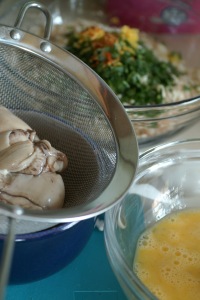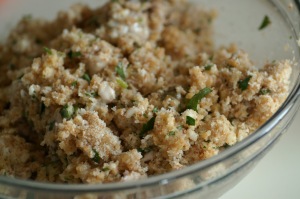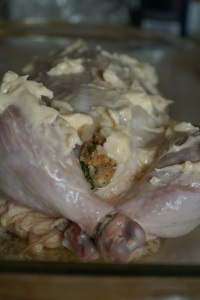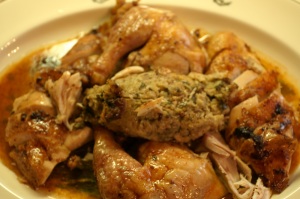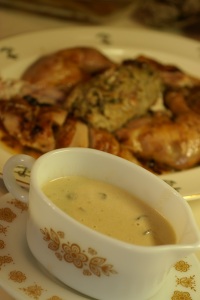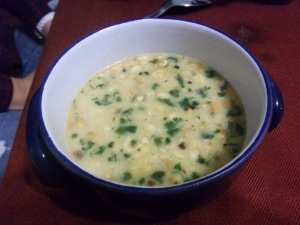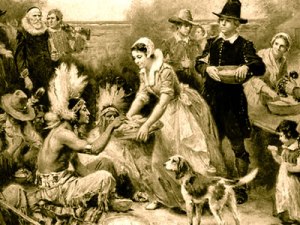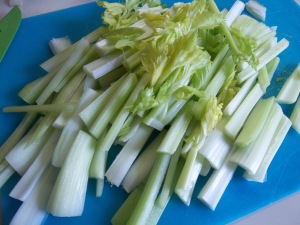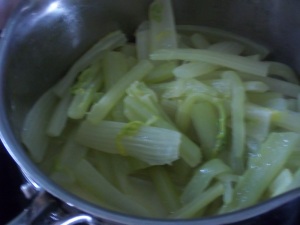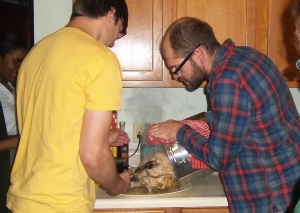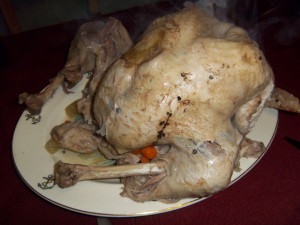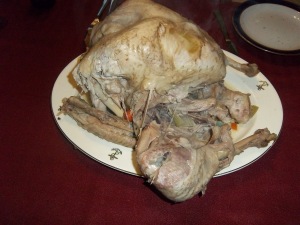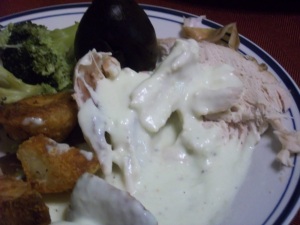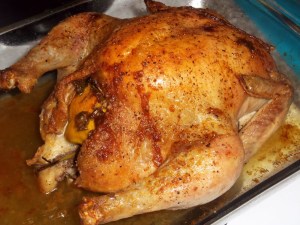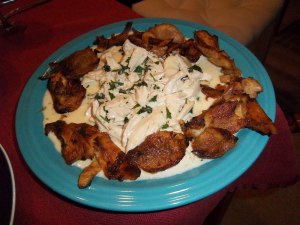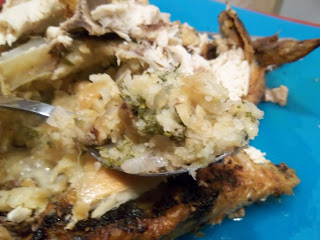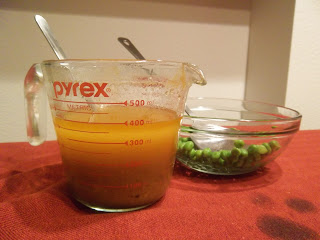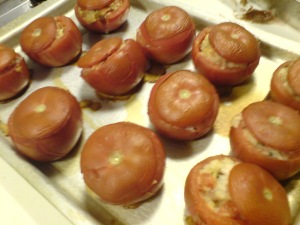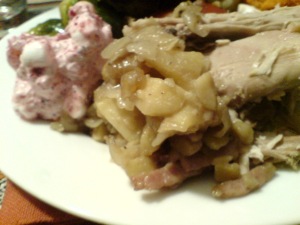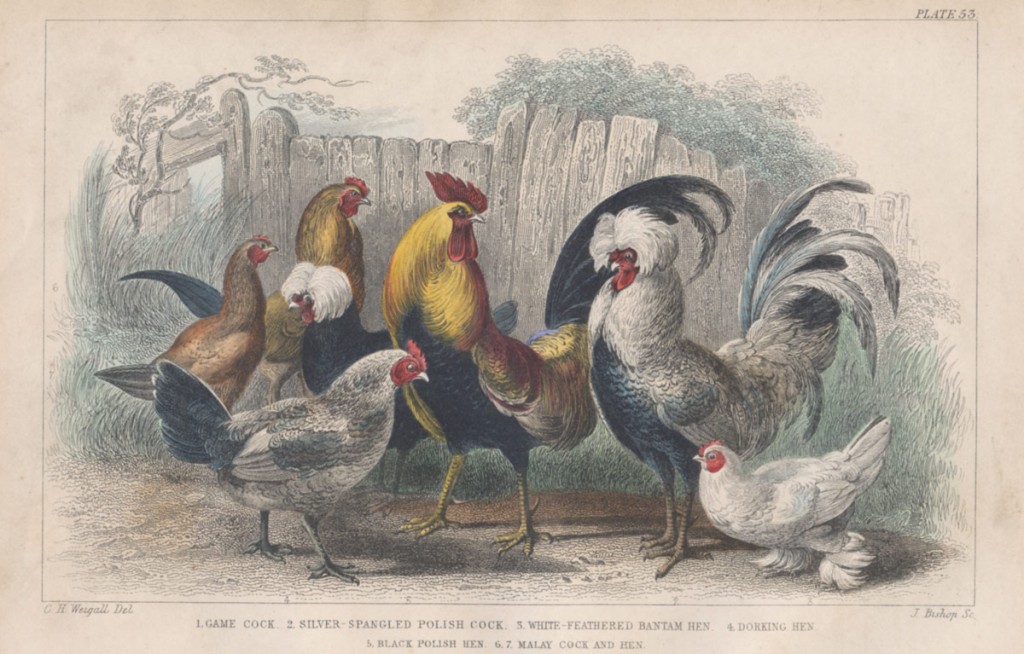
Well another milestone has been reached: with the cooking up of a vegetarian tri-gourd garnish I have completed the Poultry section of the Meat, Poultry & Game chapter of English Food by Jane Grigson. In just 18 recipes, Jane manages to cram in a surprising variety and runs the full gamut of poultry: chicken and capon, turkey, goose, duck and guineafowl are all represented(quail is covered in Game). On top of that she includes lesser used parts of birds too: neck, liver and giblets all get a mention, as do boiling fowls.
It might not surprise you that the majority of the recipes are chicken-based. I am working from her 1992 third edition a time when chicken is ubiquitous, but when she wrote the first edition in 1974, the battery ‘farms’ was in its infancy. Prior to the 1970s, chicken was an expensive meat, saved for special occasions, but with the great ‘success’ of the factory bird, it took over the world. Today there are 23 billion chickens on the planet. Jane muses: ‘Poultry and game are, for very different reasons, the mavericks of the meat trade, representing its worst – frozen battery chicken – and its best – woodcock and grouse.’ Of chicken in the 1990s she despairs: ‘I didn’t realize quite how far we had lost flavour in poultry’. What would she say now in a Britain threatened by imports of chlorinated chickens and lab-grown chicken meat?
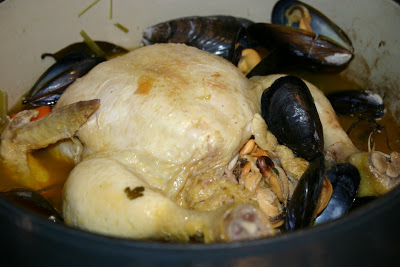
It isn’t news to anyone that the vast majority of chickens are raised in filth and squalor, but it’s not all bad, and there still places where chickens are raised free range – and I mean truly free range, not technically. Such fowls can be found at farmers’ markets across the country. Personally, I worry about the freedom of the bird other whether it is organic. A good example of this is Packington who farm their chickens (and cockerels) the traditional way. They are more expensive, and therefore I eat chicken less. It should be the way of things, after all. They have an excellent flavour that is essential for when a chicken is to be poached, say, for example, when preparing #225 Cockie-Leekie.
Only on the rare occasion I buy a chicken from a supermarket, do I insist upon it being organically farmed; for animals, being certified organic does not just mean it has been fed organic grain etc., but has received a higher standard of husbandry than for a regular farmed animal.
I am in the minority with this view. Chickens – or maybe birds in general – simply do not provoke the same empathy us that mammals do. Some possibly don’t even consider them animals at all. Maybe we would care more if they had more expressive faces, paws not claws, and fur instead of feathers.
The chapter is about more than chickens though, though Jane does make the point that our farmed poultry – especially ducks – don’t resemble the old traditional breeds either:
We know and are told too little. Wool is pulled over our eyes to the point of blindness. Take Aylesbury duck. Sounds nice and historical. It was once the preferred breed for its rich, fine deliciousness. Don’t be fooled. What you have on your plate has barely an Aylesbury gene in its body…
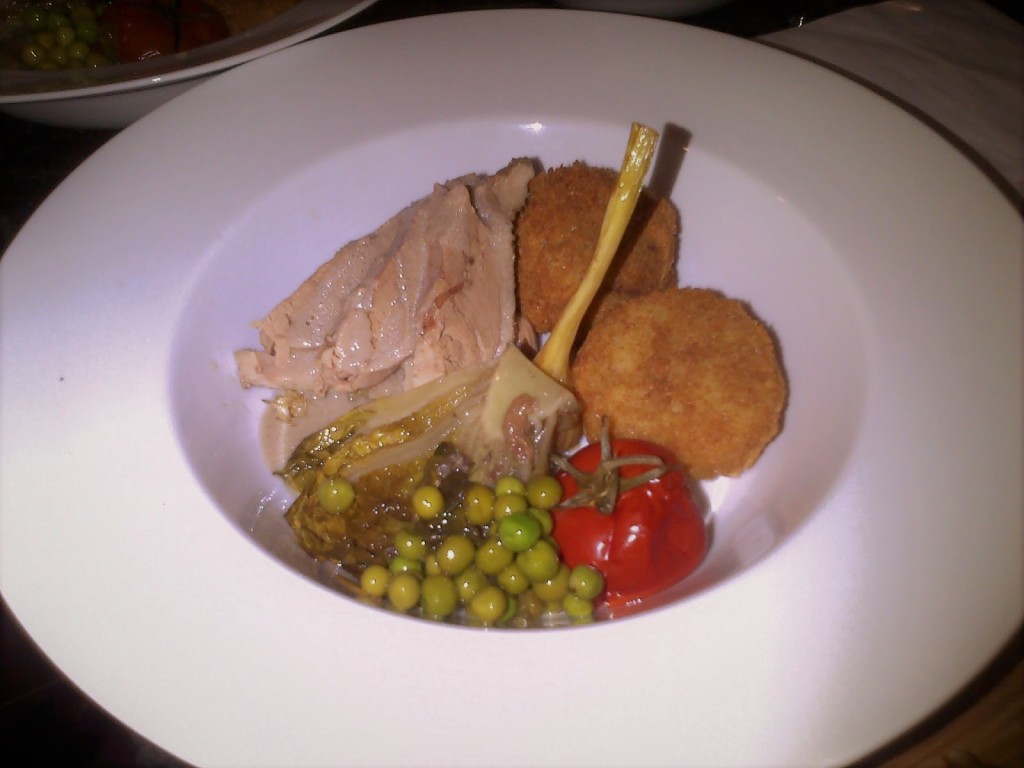
She opines too for the breeds lost because they do not fit with today’s capitalistic farming systems. Perhaps we should all buy goose – they stubbornly resist mass farming methods.
Cooking the recipes in this part of the book introduced me to a whole new world of poultry: I had never ‘boiled’ a whole turkey or eaten a capon, nor had I really cooked with poultry offal or made my own (#276) Giblet Gravy. One of the best discoveries was the delicious combination of mussels and chicken, and the deliciousness of guineafowl was a revelation.
Several recipes are now part of my repertoire, both at home and professionally, and there have been some high scorers and memorable meals. #147 Devilled Chicken Livers was the only one to score full marks, though #100 Roast Turkey with Lemon Stuffing is now a Christmas standard as is #298 Pulled and Devilled Turkey on Boxing Day. The most cooked recipe though is #225 Cockie-Leekie. I make it at home, but also cooked it up regularly when The Buttery was open. It is sublime and containing only chicken, beef, prunes and leeks, it is simplicity itself. The medieval stuffing from #405 Turkey Neck Pudding and #399 Duck Braised with Green Peas have also turned up on past menus. Lastly #442 Smoked Chicken with Three-Melon Salad simply must be attempted by anyone who owns a cold-smoker (skip the salad though).
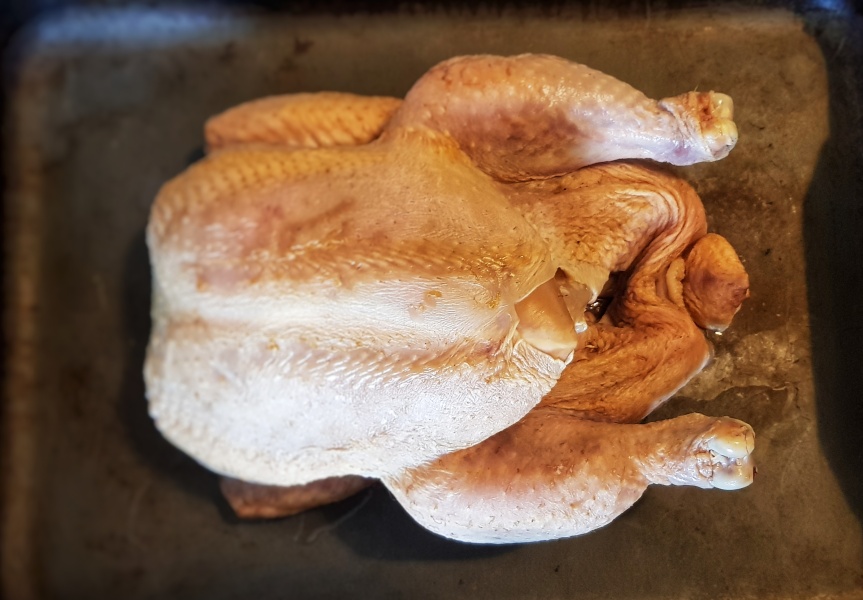
There were only a couple of duds: #443 Three-Gourd Garnish was two thirds underwhelming and one third unpalatable, the bitter gourd being so bitter, just a tiny piece was completely inedible – I, or Jane, must have got something wrong there. And then there was #339 Hindle Wakes, the bizarre cold, prune-stuffed chicken, painted with a congealed lemon sauce. In my little review of the meal, I described it as a monster, ‘a cross between something from Fanny Cradock’s 1970s repertoire and the centrepiece of a medieval feast.’ Why it would be included, and a traditional roast chicken or goose missed out, I don’t know.
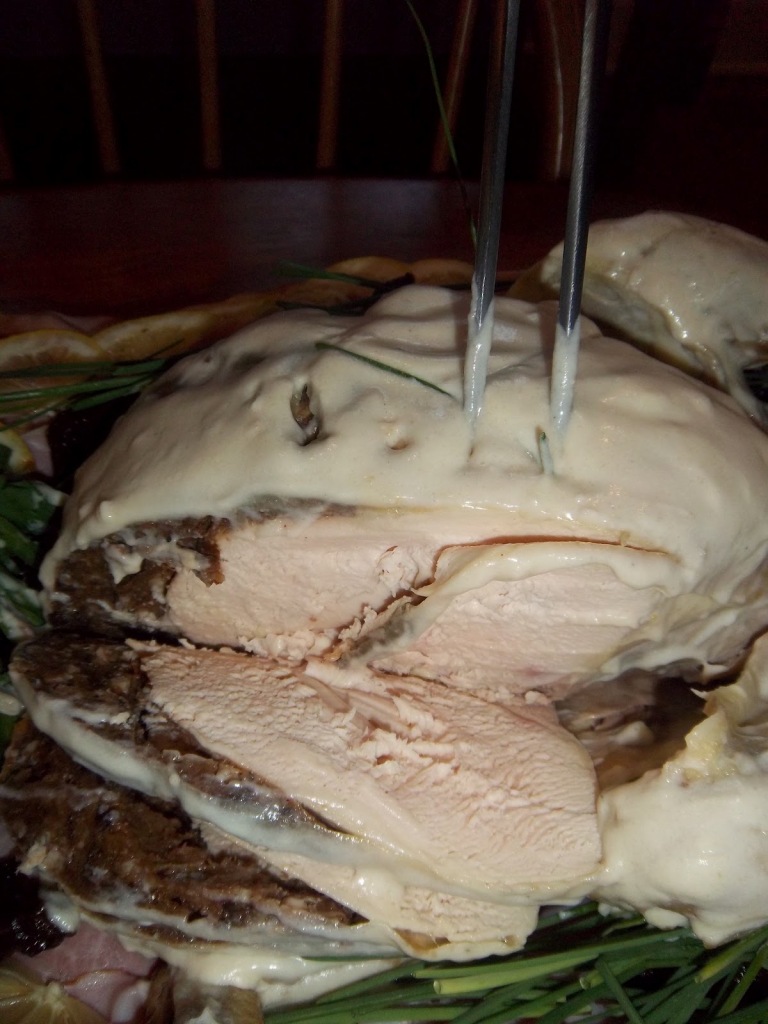
Due to a minority of poor recipes, the 18 recipes of the Poultry section scored a mean of 7.56/10, putting it in second place after Pork (8.06/10). For who like their stats, Poultry had a median and mode of 7.5. Measuring averages this, actually puts Beef & Veal at the top of the meat sections thus far, though Poultry remains in second place.
If you like the blogs and podcast I produce, please consider treating me to a virtual coffee or pint, or even a £3 monthly subscription: follow this link for more information.
As usual, I have listed the recipes below in the order they appear in the book with links to my posts and their individual scores, so have a gander. It is worth pointing out, that my posts are no substitute for Jane’s wonderful writing, so if you don’t own a copy of English Food, I suggest you get yourself one.
#335 Boiled Capon with Sugar Peas 5.5/10
#334 Salmagundi for a Middle Dish at Supper 6.5/10
#235 Lisanne’s Chicken with Mussels 7.5/10
#339 Hindle Wakes 5/10
#225 Cockie-Leekie 7.5/10
#442 Smoked Chicken with Three-Melon Salad 7.5/10
#147 Devilled Chicken Livers 10/10
#210 Coarse Chicken Liver Pâté 8.5/10
#100 Roast Turkey with Parsley and Lemon Stuffing 9.5/10
#276 Giblet Gravy 9/10
#405 Capon, Goose or Turkey Neck Pudding/Poddyng of Capoun Necke (1430) 7/10
#298 Pulled and Devilled Turkey, Chicken or Pheasant 9.5/10
#314 Boiled Turkey with Celery Sauce 7/10
#399 Duck Stewed with Green Peas 9/10
#178 Duck with Mint 7.5/10






